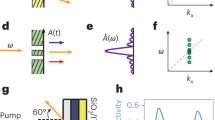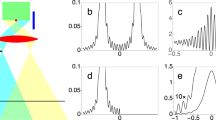Abstract
DIFFRACTION of light by an aperture is a well-known manifestation of the wave nature of light. The most familiar case is that of an incident plane wave, which is diffracted into a spatial pattern that is sensitive to the properties of the aperture: the ratio of transmitted power to incident flux (the transmission cross-section σ) depends in a complicated way on the aperture area A (refs 1–3). For diffuse (that is, isotropic rather than plane-wave) illumination, however, the situation is much simpler4: in three dimensions, σ increases with A in a series of steps of equal height λ2/2π (where λ is the wavelength of the light), and is thus independent of the detailed aperture shape. A similar simplification occurs for two-dimensional diffuse illumination of a slit: the transmission cross-section per unit slit length increases in stepwise fashion as a function of the slit width W, with steps of height λ/2 occurring whenever W = nλ/2 (n = 1,2,3,…)—that is, whenever a new mode is enabled in the slit. Although the optical transmission characteristics of slits have been studied extensively for plane-wave illumination5–8, we know of no investigation of this predicted staircase dependence for diffuse illumination. Here we report the observation of such an effect, and suggest that it may play a part in any process of wave propagation through a constriction.
This is a preview of subscription content, access via your institution
Access options
Subscribe to this journal
Receive 51 print issues and online access
$199.00 per year
only $3.90 per issue
Buy this article
- Purchase on Springer Link
- Instant access to full article PDF
Prices may be subject to local taxes which are calculated during checkout
Similar content being viewed by others
References
Bouwkamp, C. J. Rep. Progr. Phys. 17, 35–100 (1954).
Bowman, J. J., Senior, T. B. A. & Uslenghi, P. L. E. Electromagnetic and Acoustic Scattering by Simple Shapes (North-Holland, Amsterdam, 1969).
Jackson, J. D. Classical Electrodynamics 2nd edn (Wiley, New York, 1975).
Van Houten, H. & Beenakker, C. W. J. in Analogies in Optics and Microelectronics (eds. Van Haeringen, W. & Lenstra, D.) 203–225 (Kluwer, Dordrecht, 1990).
Kashyap, S. C. & Hamid, M. A. K. IEEE Trans, on Antennas and Propagation 19, 499–507 (1971).
Neerhoff, F. L. & Mur, G. Appl. Sci. Res. 28, 73–88 (1973).
Elsherbeni, A. Z. & Hamid, M. Can. J. Phys. 65, 16–22 (1987).
Lightbody, M. T. & Flddy, M. A. Adv. in Electronics and Electron Physics 19, 61–67 (1987).
Van Wees, B. J. et al. Phys. Rev. Lett. 60, 848–850 (1988).
Wharam, D. A. et al. J. Phys. C21, L209–L214 (1988).
Van der Mark, M. B. thesis, Univ. Amsterdam (1990).
Szafer, A. & Stone, A. D. Phys. Rev. Lett. 62, 300–303 (1989).
Author information
Authors and Affiliations
Rights and permissions
About this article
Cite this article
Montie, E., Cosman, E., 't Hooft, G. et al. Observation of the optical analogue of quantized conductance of a point contact. Nature 350, 594–595 (1991). https://doi.org/10.1038/350594a0
Received:
Accepted:
Issue Date:
DOI: https://doi.org/10.1038/350594a0
This article is cited by
-
Electron tunneling between vibrating atoms in a copper nano-filament
Scientific Reports (2021)
-
Conductance Quantization in Resistive Random Access Memory
Nanoscale Research Letters (2015)
-
Magnetoresistance of Cu–Ni nanoparticles in hydrogenated amorphous carbon thin films
Journal of Materials Science: Materials in Electronics (2015)
-
Quantized magnetoresistance in atomic-size contacts
Nature Nanotechnology (2007)
-
Observation of magnetically induced transverse diffusion of light
Nature (1996)
Comments
By submitting a comment you agree to abide by our Terms and Community Guidelines. If you find something abusive or that does not comply with our terms or guidelines please flag it as inappropriate.



